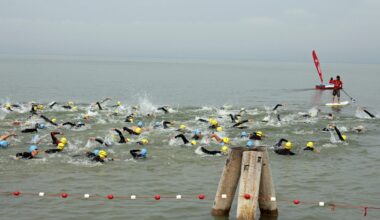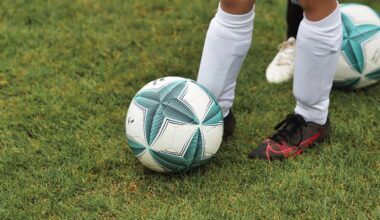How to Perform the Precision Jump with Perfect Accuracy
The precision jump is an essential skill in freerunning, often used to traverse gaps and barriers effectively. A well-executed precision jump can instill confidence and increase safety when navigating urban environments. To begin mastering this move, it’s important to start with a proper warm-up, ensuring that your muscles and joints are flexible. This reduces the risk of injury and prepares your body for the demands of freerunning. Focus on dynamic stretches that target your legs, hips, and core, which are vital for this jump. Next, find a suitable practice area with an inclined surface to enhance your jump distance. Begin with smaller gaps and progressively work up to larger distances. While practicing your jumps, concentrate on your landing technique, aiming for soft landings with bent knees. This will help you absorb the impact and maintain balance. Always wear comfortable shoes that provide good grip to prevent slipping. Additionally, consider filming your attempts to analyze your form and make adjustments where necessary. Paying attention to every detail will significantly enhance your performance and precision.
To further improve your precision jump, visualize the technique step-by-step. Envision your takeoff and landing points before executing the jump. This mental preparation can greatly benefit your execution. Start with an approach, maintaining a steady rhythm to gather momentum. Once you reach the edge of your takeoff spot, position your feet shoulder-width apart, allowing for better balance. Bend your knees slightly, positioning your arms in a way that they can help propel you forward. As you jump, channel energy through your legs and swing your arms forward to gain height and distance. Focus on landing softly without rolling your ankles. When practicing, consider engaging a trainer or more experienced freerunner who can provide feedback on your form. The option of practicing against a soft surface like grass or a mat can also ensure a safe environment if you fail to land perfectly. Consistent practice will lead to muscle memory, making the precision jump feel natural over time. Along with that, don’t be afraid to challenge yourself. But remember to safety first; protective gear is encouraged during tricky jump assessments.
Key Techniques for Mastering the Precision Jump
Various key techniques are essential in mastering the precision jump effectively, enhancing both technique and safety. One of the primary focuses is to ensure your weight distribution is optimal throughout the movement. This means consistent practice focusing on pushing off with your strong leg while keeping your other leg extended for balance. A good way to achieve this is to train on flat surfaces where you can easily adjust your form. Use visual aids such as cones or markers to set distance benchmarks. When you’ve built up enough confidence, gradually increase the distance between these markers. It’s also essential to practice the control of your landings; aim to touch down softly, keeping a slight bend in the knees to absorb shock. This technique greatly reduces the risk of injuries that could occur from hard landings. Incorporating plyometric exercises, like box jumps or depth jumps, into your training can enhance your overall power and explosiveness. Also, remember that many famous freerunners often critique their jumping techniques regularly, leading to continuous improvement. Small changes to foot positioning or body lean can have a significant impact on the outcome.
Training for the precision jump involves not just physical practice but also mental conditioning. Developing a mindset that embraces challenges is vital in the world of freerunning. Visualization practices can enhance your ability, allowing you to mentally rehearse the jumps before physically attempting them. Writing down your goals and tracking progress is equally essential; keeping a journal can help identify strengths and weaknesses in your technique. In every session, allocate time specifically for reviewing foot placements and body alignment during jumps. Consistent repetition leads to the formation of muscle memory, improving your overall technique significantly. Furthermore, practicing with peers can foster a competitive atmosphere, driving improvement in both skill and confidence. Peer feedback offers insights that you may have overlooked. Additionally, participating in workshops led by professionals can provide new perspectives on the precision jump and freerunning techniques. Being open to learning from others accelerates the developing process. Always remember that every freerunner faces frustrations along their journey, so patience is key. Try not to rush your progress; the endurance gained through consistent practice is what will set you apart in performance.
Common Mistakes to Avoid
As you hone your precision jump skills, be on guard against common mistakes that can hinder your progress. One major pitfall is attempting to jump too far too soon. Aiming for overconfidence without the necessary foundational skills can lead to falls and injuries. Focus on mastering shorter distances before increasing gaps, ensuring your form remains intact throughout the process. Another frequent issue is improper body positioning during takeoff. Ensure you maintain a strong posture, aligning your body correctly to maximize lift-off without compromising your balance. Many freerunners also fail to land with a stable center of gravity, which leads to stumbling or falling. Always prepare to bend your knees during landing to absorb impact properly. Neglecting the importance of footwear is another critical mistake. Wearing worn-out or non-grippy shoes can lead to slips, jeopardizing not only your jumping but your overall safety. Regularly check your shoes and ensure they’re appropriate for freerunning. Lastly, don’t overlook the importance of practice efficiency; ensure your training sessions focus primarily on skill refinement rather than just repetitive jumps.
For those looking to progress further with the precision jump, engaging in cross-training activities can provide a broader skill set and reduce the chance of injury. Enrolling in classes like gymnastics or dance can enhance body control and spatial awareness, essential qualities for a successful freerunner. These activities teach you to understand how your body moves through space, translating efficiently into freerunning and precision jumps. Strength training focused on the lower body also supports explosive ground power, critical for takeoffs. Combine your jump training with agility drills that can enhance your reflexes and quick footwork, enabling better decision-making during freerunning sessions. Additionally, flexibility training is equally crucial; it enhances your range of motion, allowing for smoother jumps and landings. Pilates and yoga are excellent platforms to improve flexibility and body alignment. Lastly, engage in active recovery methods such as foam rolling or swimming. These can help your body recuperate faster, allowing you to train more effectively. Keep pushing your limits, but prioritize your health and safety above all, ensuring a long career in freerunning.
Conclusion and Future Steps
Mastering the precision jump is not merely about jumping over gaps; it represents a mindset focused on overcoming obstacles. The growth achieved through persistent practice is invaluable, both personally and in skill advancement. Emphasize continued education in freerunning techniques and attend community events to learn from others. As this dynamic sport continues evolving, staying informed about trends and innovations is vital. Additionally, document your experiences in a blog or video diary to reflect on your growth. Engaging with online forums and social media groups for freerunners can provide a sense of community and belonging. Sharing your successes and challenges with others can create bonds and foster motivation. Set new goals regularly to ensure you’re continually pushing yourself further. Consider exploring related disciplines like parkour, which can complement your freerunning skills and broaden your horizons. Always maintain a positive attitude, even when faced with challenges; the journey is as important as the end result. Ultimately, your dedication to improving will yield a more satisfying and successful freerunning experience.
So, step into the world of precision jumps with inspiration and determination. Incorporate these techniques, and don’t shy away from challenges, as they will help refine your skills over time. With regular training, a focus on detailed execution, and the right mindset, accuracy will come naturally. Lead with passion, and enjoy the journey while ascending to new heights in the breathtaking world of freerunning. Connecting with peers and coaches will encourage growth in both areas of precision jumps and overall freerunning performance. Record your achievements regularly and celebrate milestones, no matter how small they may seem. This keeps motivation levels high and encourages further commitment to the craft. Every jump you master adds to the foundation of a versatile freerunner, setting you apart in this thrilling discipline. With dedication and practice, you’ll cultivate skills that others look up to. So lace up your shoes, find your nearest practice spot, and leap into action. Remember, the sky’s the limit when it comes to improving your precision jump! Happy training!


